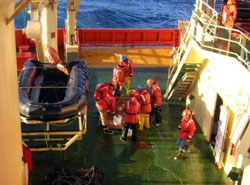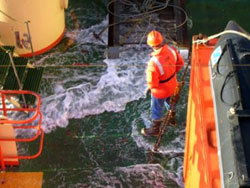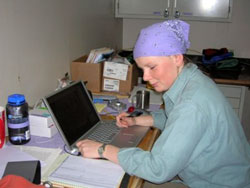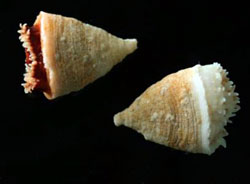Dispatch: May 16, 2006
|
|
Lat/Long: S-053 43.184 W-059 40.815
Temperature: 8.2 degrees Centigrade
Wind Chill: -4.9 degrees Centigrade
Wind: NNW at 31 km/h
Dinner menu: Blackened salmon, beef stew, Brussels sprouts, spinach, broccoli, fresh salad, and carrot cake

Deck operations - benthic team hovers over the sorting
box... (Photo by Ellen Bailey)
|
It was a bit rough for sorting this morning's Blake trawl. Every so often a really large wave would come through and soak the deck - up to one's knees. The benthic crew eventually moved the deck sorting operation indoors (well, sort of - the aquarium room), and proceeded nicely. It was more of the same the next couple of times with rough seas and winds 35-40 knots.

...while decks get a regular rinsing! (Photo by Ellen Bailey)
|
I was fortunate to get to work in the lab today with Rhian Waller. We took samples of coral from the ocean bottom, and they will be DNA-analyzed back in the United States. Some tools of the trade you might not be aware of from the Auburn website list... Dremel tool, hammer...this is not unlike brain surgery. Rhian was excited to find some 'brooding corals' in the batch (how about that, and I thought you had to wait until they were age 12 or 13!!). The brooded juvenile looked to the eye like the yolk of an egg - but textbook electron microscopy shows details already forming for the mouth and tentacles. In a matter of hours, these fast-developing babies had become more mature 'morphing' cylinders. To be able to see this development happening so quickly will be beneficial to Rhian's study both here and back at home. So, while we're on the subject...

Dr. Rhian Waller, Postdoctoral Investigator at the Woods Hole Oceanographic Institution (WHOI). (Photo by Ellen Bailey)
|
Getting to Know You - Dr. Rhian Waller
Rhian did her undergraduate work at the University of Mid-Wales at Aberystyth, and received her PhD from Southampton University, England.
Rhian is here to help the main project in any way she can, but on the side she is able to perform some research of her own. I started to learn about Rhian's project when we drove all over Punta Arenas looking for aquarium supplies for her anticipated ocean bottom coral. The plan is to put several small corals flabellum curvatum into aquaria environments, and see if she can get them to spawn or 'have babies'. This will help her with future study using genetics to learn how these coral reproduce.

Flabellum curvatum, red and white (Photo by Susie
Balser)
|
We have a few extra people on board who needed to get from Chile to Palmer Station
in Antarctica. Palmer is on Anvers Island on the west side of
the peninsula. These people are each integral to the station
in some context that makes them officially able to 'hitch a
ride' with the L. M. Gould. The payoff is, however,
that they must be along for the ride for as long as it takes
us to get there - a side trip here, some science to be done
there.... But all are in our midst as we do what we do, and
I'm sure we'll notice a void when they leave us. Jack Baldelli,
for one, has shared some amazing photos of the sea birds he's
been taking, as well as his knowledge in identifying them for
us. He's going to Palmer as a diver to do some saltwater intake
pipe maintenance. Neel Pahl is a firefighter who has a special
safety project at Palmer. Toby Koffman is a boating coordinator
at Palmer, usually in the summer months, but is going out now
to cover for a counterpart at that job. At this time of year
there will be some boating, but mostly station boat maintenance.
Some of these folks will be coming back with us at the end of
our trip, others will stay longer. They say that September is
the worst month for access to Palmer, when it really gets iced
in, so there will still be a window of navigable weather there
for a couple of months more.
Another side trip we'll take will be to deliver repair supplies to a sailing research vessel in one of the islands on the way to Anvers. Really, this territory is so specialized as far as access goes, it takes teamwork to keep everyone going, and we're happy to be a part of that.
back
|
|